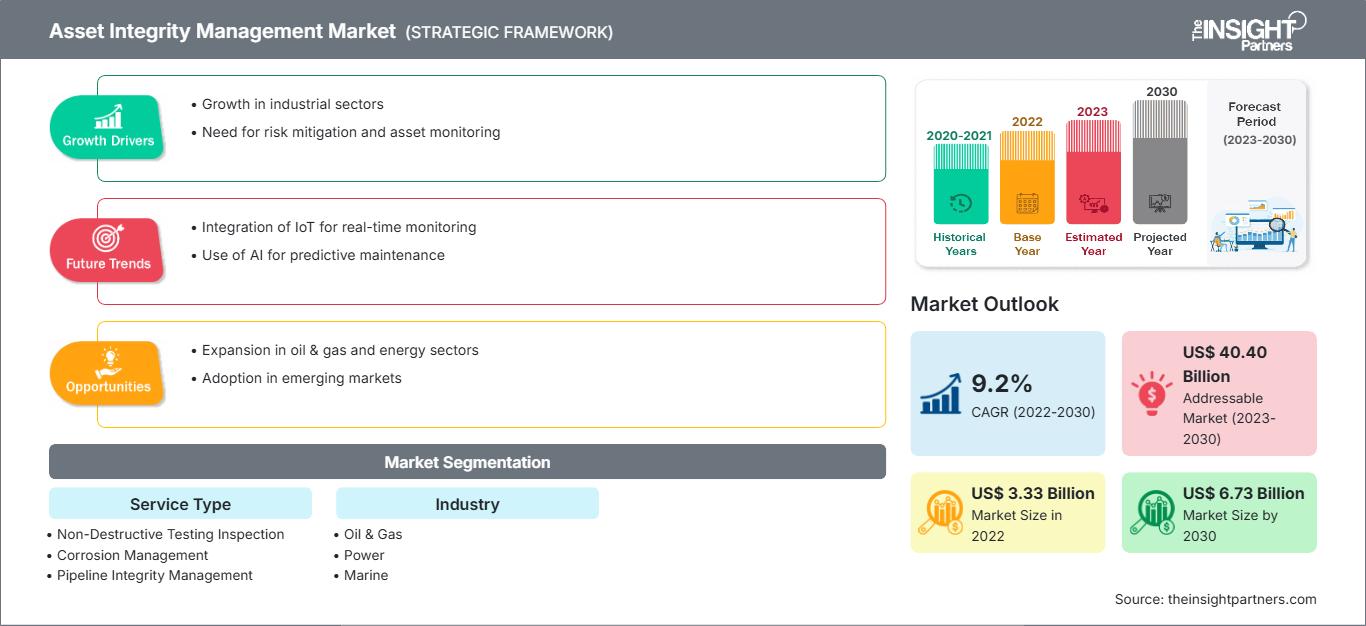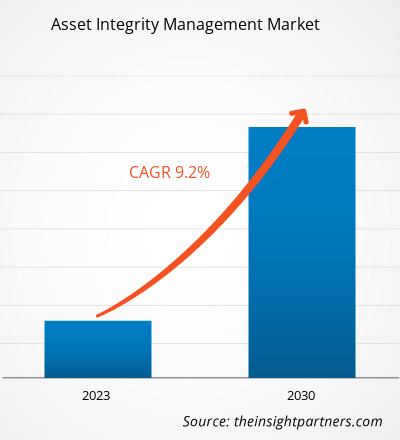[연구 보고서] 자산 무결성 관리(AIM) 시장은 2022년 33억 3천만 달러 규모로 평가되었으며, 2030년까지 67억 3천만 달러에 이를 것으로 예상됩니다. 2022년부터 2030년까지 연평균 성장률(CAGR)은 9.2%에 이를 것으로 예상됩니다. 자산 무결성 관리 시장 동향에는 IIoT와 자산 무결성 관리 솔루션의 통합이 포함됩니다.
분석가 관점:
자산 무결성 관리 시장 전망은 이 시장의 이해관계자들이 성장 전략을 수립하는 데 도움이 될 수 있습니다. 자산 무결성 관리 시스템은 기업의 성공적인 운영을 유지하면서 위험과 리스크를 최소화하기 위해 거버넌스 및 모니터링과 같은 모든 자산 활동과 연계됩니다. 위험 기반 산업에서 노후 자산의 운영 안전성에 대한 필요성이 증가함에 따라 자산 무결성 관리 시장이 성장하고 있습니다.
석유 및 가스, 광업, 전력 산업의 자산 운영 효율성은 가장 중요한 요소로 간주됩니다. 따라서 생산성 극대화를 위해서는 이러한 자산의 정기적인 유지보수가 중요합니다. 화학 물질과 석유 및 가스 제품은 부식성과 가연성이 높기 때문에 전반적인 운영 효율성과 안전을 위해 장비의 지속적인 점검 및 유지보수가 필요합니다. 또한, 여러 국가에서 석유 및 가스 수요 증가와 전력 산업의 성장에 따른 석유 및 가스 산업의 확장은 예측 기간 동안 자산 무결성 관리 시장 성장에 여러 기회를 창출할 것으로 예상됩니다. 다양한 산업 분야에서 디지털 혁신이 확대됨에 따라 석유 및 가스 산업은 전 세계 산업 혁명과 경제 성장에 중요한 역할을 합니다. 이 산업의 발전을 이끄는 주요 요인은 인구 증가로 인한 전기, 전력, 자동차, 항공기에 대한 높은 수요입니다. 전 세계적으로 기존 석유 매장량 고갈로 인한 에너지 수요 증가를 충족하기 위해 석유 공급이 빠르게 증가할 것으로 예상됩니다. 국제에너지기구(IEA)에 따르면, 2023년 6월 기준 전 세계 석유 수요는 석유화학 및 항공 산업의 폭발적인 수요 증가로 인해 2022년부터 2028년까지 6% 증가하여 하루 1억 570만 배럴(mb/d)에 이를 것으로 예상됩니다. 따라서 석유화학 및 항공 부문의 석유 및 가스 수요 증가는 석유 및 가스 산업을 성장시키고 자산 무결성 관리(ABM) 시장 점유율 확대를 촉진하고 있습니다.
이 보고서의 일부, 국가 수준 분석, Excel 데이터 팩을 포함하여 모든 보고서에 대한 사용자 정의를 무료로 받을 수 있을 뿐만 아니라 스타트업 및 대학을 위한 훌륭한 제안 및 할인을 이용할 수 있습니다
자산 무결성 관리 시장: 전략적 통찰력

-
이 보고서의 주요 주요 시장 동향을 확인하세요.이 무료 샘플에는 시장 동향부터 추정 및 예측에 이르기까지 데이터 분석이 포함됩니다.
자산 무결성 관리 시장 개요:
자산 무결성 관리(AIM)는 장비, 건강 및 환경 보호에 중점을 둔 자산 관리 표준의 한 형태입니다. 자산의 일관된 기능을 효과적이고 효율적으로 유지하며, 위험 감소, 신뢰성 향상, 안전성 증대, 환경 성과 개선 등 여러 가지 이점을 제공합니다. 이는 석유 및 가스, 광업, 항공우주 및 기타 산업에서 일반적으로 사용됩니다.
자산 무결성 관리 시장은 향후 몇 년간 성장할 것으로 예상됩니다. 이는 위험 기반 산업에서 노후 자산의 운영 안전성에 대한 필요성 증가와 엄격한 정부 주도 안전 규제 등 다양한 요인에 기인합니다. 또한, 석유 및 가스 산업의 확장과 석유 및 가스 수요 증가는 향후 몇 년간 시장 참여자들에게 성장 기회를 제공할 것으로 예상됩니다. 그러나 비부가가치 유지 관리 및 부적절한 자산 운영에 드는 비용은 자산 무결성 관리 시장 성장을 저해하고 있습니다.
자산 무결성 관리 시장 성장 동력:
위험 기반 산업에서 노후 자산의 운영 안전성에 대한 필요성 증가
자산 무결성 관리 소프트웨어는 자산의 효과적인 기능 수행 능력을 보호하고 기업 자산을 관리하여 수익성을 확보합니다. 자산 무결성 관리 소프트웨어는 설계, 검사, 유지보수 및 운영을 포함한 다양한 서비스를 제공하며, 이는 인프라 및 장비의 무결성에 큰 영향을 미칩니다. 또한 감사, 검사, 전반적인 품질 프로세스 및 자산의 효과적인 무결성 관리를 위한 기타 도구도 제공합니다. 석유화학, 석유 및 가스, 재생 에너지, 전력 및 인프라와 같은 산업은 생산성 향상과 동시에 환경 및 안전 문제를 해결하기 위해 이러한 서비스를 선택합니다. 이러한 산업은 위험 기반이며 자산 기반이 강하기 때문에 자산의 유지보수 및 검사가 필수적입니다. 석유 및 가스 산업에서 가스 산업에서 성과 및 운영 위험 수준은 해저 장비, 플랫폼 상부 구조물, 구조물, 가스 처리 플랜트, 파이프라인, 정유소, 압축기, 가스 분배 네트워크 등 가치 사슬 전반에 걸친 자산의 무결성에 따라 달라집니다. 석유 및 가스, 광업, 전력 산업에서는 자산의 운영 효율성이 매우 중요하므로 생산성을 극대화하기 위해서는 이러한 자산의 정기적인 유지보수가 중요합니다. 따라서 자산 무결성 관리 솔루션을 통한 운영 안전 확보의 필요성이 자산 무결성 관리 시장을 주도하고 있습니다. 화학 물질 및 석유 및 가스 제품은 부식성과 가연성이 강하기 때문에 전반적인 운영 효율성과 안전성을 위해 장비의 지속적인 점검 및 유지보수가 필요합니다. 자산 무결성 관리 서비스는 장비의 신뢰성, 생산성, 안전성을 향상시켜 지속적인 품질 성능을 달성합니다. 전 세계 다양한 시장 참여자들이 성과 및 운영 위험을 관리하기 위한 자산 무결성 관리 소프트웨어를 제공하고 있습니다. 예를 들어, DNV Group AS는 석유 및 가스와 같은 위험 기반 산업에서 효과적인 위험 기반 무결성 관리를 지원하는 핵심 플랫폼을 제공하는 Synergi 자산 무결성 소프트웨어 제품군을 제공합니다. 따라서 위험 기반 산업에서 노후 자산의 운영 안전성에 대한 필요성은 자산 무결성 관리(AIM) 시장 규모 확대에 기여하는 요인 중 하나입니다.
세분화 분석:
자산 무결성 관리 시장은 서비스 유형과 산업으로 구분됩니다. 서비스 유형에 따라 시장은 비파괴 검사(NDT) 검사, 부식 관리, 파이프라인 무결성 관리, 구조 무결성 관리, 위험 기반 검사(RBI) 등으로 세분화됩니다. 산업별로는 석유 및 가스, 전력, 해양, 광업, 항공우주 등으로 세분화됩니다.
지역 분석:
자산 무결성 관리 시장
보고서에는 북미, 유럽, 아시아 태평양, 중동 및 아프리카, 중남미가 포함됩니다. 매출 측면에서는 북미가 자산 무결성 관리 시장 점유율을 주도했습니다. 북미 자산 무결성 관리 시장은 미국, 캐나다, 멕시코로 세분화됩니다. 세 국가 모두 지난 몇 년 동안 자산 무결성 관리 서비스 도입이 증가하고 있습니다. 석유 및 가스, 화학, 전력, 천연자원 산업은 운영을 위해 자체 인프라에 의존하고 있으며, 이러한 인프라는 빠르게 노후화되어 고장 위험이 커지고 있습니다.석유 및 가스 산업에서 대부분의 노후 유전의 인프라는 노후되어 부식, 스케일링, 유정 장비 손상 등 유정 무결성 문제를 야기합니다. 이러한 문제는 기업과 유틸리티 기업의 운영 위험을 증가시켜 인프라 업그레이드 프로젝트에 더 많은 자본을 필요로 합니다. 북미 지역의 석유 및 가스 산업은 환경 보호, 문화 자원 보존, 근로자의 건강과 안전 보호를 위해 여러 정부 정책과 규정을 준수해야 합니다. 이 지역의 상류 및 중류 인프라는 막대합니다.
미국은 석유 및 천연가스 최대 생산국으로, 탐사, 정제, 운송 활동을 포함합니다. 또한 미국에서는 시추업체들이 새로운 석유 굴착 장치를 추가하여 총 석유 굴착 장치 수가 862개가 되었습니다.미국은 250만 km가 넘는 석유 및 가스 파이프라인을 보유하고 있는 반면, 캐나다는 약 80만 km의 파이프라인을 보유하고 있습니다.대규모의 노후화된 인프라로 인해 북미는 예측 기간 동안 시장을 지배할 가능성이 높습니다.또한 미국은 세계에서 가장 오래된 발전 시스템 중 일부를 보유하고 있습니다.미국은 세계 최고의 에너지 생산국이며, 수압 파쇄와 수평 시추는 이 나라의 에너지 생산량을 늘리는 데 도움이 된 기술입니다.따라서 엄격한 정부 규제와 거대한 가스 파이프라인 네트워크의 존재는 다양한 산업에서 자산 무결성 관리 도입을 늘릴 수 있는 기회를 창출할 것으로 예상되며, 이는 북미 자산 무결성 관리 시장 성장을 촉진할 가능성이 높습니다.
주요 업체 분석:
자산 무결성 관리 시장 분석은 SGS AG, Intertek Group plc, Aker Solutions ASA, Bureau Veritas SA, Fluor Corporation과 같은 주요 업체의 연간 실적을 기반으로 합니다. DNV GL AS, John Wood Group PLC, Oceaneering International, Inc., Rosen Group, 그리고 Cybernetix SA. 자산 무결성 관리(AIM) 시장과 생태계에 대한 전체적인 관점을 얻기 위해 여러 주요 자산 무결성 관리(AIM) 시장 참여 기업들을 분석했습니다. 본 보고서는 시장을 주도하는 주요 요인과 주요 기업들의 발전을 강조합니다.
자산 무결성 관리 시장 지역별 통찰력
The Insight Partners의 분석가들은 예측 기간 동안 자산 건전성 관리(ABM) 시장에 영향을 미치는 지역별 동향과 요인을 면밀히 분석했습니다. 이 섹션에서는 북미, 유럽, 아시아 태평양, 중동 및 아프리카, 중남미 지역의 자산 건전성 관리 시장 부문 및 지역별 현황도 다룹니다.
자산 무결성 관리 시장 보고서 범위
| 보고서 속성 | 세부 |
|---|---|
| 시장 규모 2022 | US$ 3.33 Billion |
| 시장규모별 2030 | US$ 6.73 Billion |
| 글로벌 CAGR (2022 - 2030) | 9.2% |
| 이전 데이터 | 2020-2021 |
| 예측 기간 | 2023-2030 |
| 다루는 세그먼트 |
By 서비스 유형
|
| 포함된 지역 및 국가 |
북미
|
| 시장 선도 기업 및 주요 회사 프로필 |
|
자산 무결성 관리 시장 참여자 밀도: 비즈니스 역학에 미치는 영향 이해
자산 건전성 관리 시장은 소비자 선호도 변화, 기술 발전, 그리고 제품 이점에 대한 인식 제고 등의 요인으로 인한 최종 사용자 수요 증가에 힘입어 빠르게 성장하고 있습니다. 수요가 증가함에 따라 기업들은 제품 및 서비스를 확장하고, 소비자 니즈를 충족하기 위한 혁신을 추진하며, 새로운 트렌드를 적극 활용하고 있으며, 이는 시장 성장을 더욱 가속화하고 있습니다.

- 을 얻으세요 자산 무결성 관리 시장 주요 주요 플레이어 개요
자산 무결성 관리(AIM) 시장 기업들은 사업 성장을 위해 비계량적 전략과 유기적 전략 모두에 집중합니다. 위 자산 무결성 관리 시장 참여 기업들의 최근 주요 시장 동향은 다음과 같습니다.
- 2023년 5월, SGS는 UAE 아부다비에서 열린 중동 자산 무결성 관리 컨퍼런스 및 쇼케이스(AIMCS)에 참가했습니다. 이 행사는 ADNOC Gas Processing의 기술 의장 하에 개최되었습니다. 300명이 넘는 업계 전문가와 전문가들이 초대되어 자산 무결성 관리의 최신 동향과 모범 사례를 논의했습니다.
- 2021년 3월, Fluor의 자회사인 Stork는 Chrysaor Holdings Limited와 영국에서 통합 전문 자산 무결성 서비스를 제공하기 위한 2년 계약 연장을 체결했습니다. Stork는 북해 중부의 Armada, Everest, Lomond 플랫폼에 대한 이 계약을 통해 해양 자산의 수명 주기를 연장하는 포괄적인 자산 관리 솔루션과 역량을 지속적으로 제공할 것입니다.
- 과거 분석(2년), 기준 연도, CAGR을 포함한 예측(7년)
- PEST 및 SWOT 분석
- 시장 규모 가치/거래량 - 글로벌, 지역, 국가
- 산업 및 경쟁 환경
- Excel 데이터세트
최근 보고서
관련 보고서
사용 후기
구매 이유
- 정보에 기반한 의사 결정
- 시장 역학 이해
- 경쟁 분석
- 고객 인사이트
- 시장 예측
- 위험 완화
- 전략 기획
- 투자 타당성 분석
- 신흥 시장 파악
- 마케팅 전략 강화
- 운영 효율성 향상
- 규제 동향에 발맞춰 대응






















 무료 샘플 받기 - 자산 무결성 관리 시장
무료 샘플 받기 - 자산 무결성 관리 시장